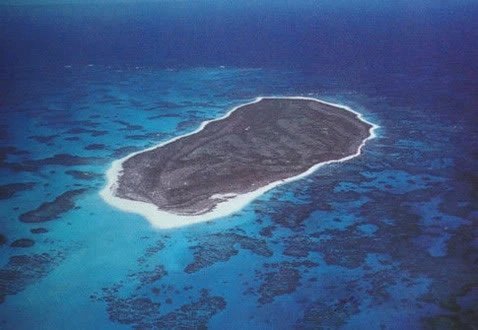Lisianski Island

Situated 1,041 miles (1,676 km) northwest of Honolulu, Lisianski Island (Papa'āpoho) has a maximum elevation of 40 feet (12 m) above sea level. The highest peak is a sand dune. Encompassing 0.601 square miles (1.556 km²), Lisianski is a small island, but it has an extensive reef to the southeast called Neva Shoals. It covers 378 square miles (979 km²), which is almost the size of the island of Oahu. Lisianski is one of the Northwestern Hawaiian Islands.
Lisianski Island is volcanic and undergoing a slow erosive process. A depression is located between two tall sand dunes. It is believed that it once was a lagoon. Because of that, the island is known as Papa'āpoho in Hawaiian. The name Lisianski comes from an officer in the Imperial Russian Navy, Yuri Feodorovich Lisyansky, whose ship Neva ran aground on the island in 1805 after spotting a Hawaiian gourd calabash on the beach.
Mice were introduced to Lisianski in 1844, when ship picking up survivors of a shipwreck brought the animals with it. Rabbits were introduced later and along with the mice, they destroyed the island's ecology. Lisianski was claimed by King Kamehameha IV for the Hawaiian Kingdom in 1857.
In 1890, the North Pacific Phosphate and Fertilizer Company obtained a 26-year lease on the island. Feather collecting began on Lisianski around the year 1904. But because of the public outcry about the feather trade, Lisianski became part of the Hawaiian Islands Bird Reservation in 1909, which was established by U.S. President Roosevelt. A year later, an armed party came to Lisianski and arrested feather poachers. They confiscated and destroyed about 1.4 tons of feathers.
Today, over three-quarters of the bonin petrels that nest in Hawaii live here. Also, Hawaiian green sea turtles and monk seals frequent Lisianski's white-sand beaches. Migratory shorebirds that come here include the ulili (wandering tattler), kolea (golden plover) and kioea (bristle-thighed curlew). More than a million sooty terns fly to Lisianski in some years.
The Neva Shoals surrounding Lisianski Island has been described as a "coral garden" because of the great variety of corals found here (24 types were identified). They look very beautiful and feature a variety of growth forms, including structures that look like castles and spires. The reef fish that live here are abundant and diverse as well. Researchers have found the sharks that live here to be very aggressive, and even the ulua (trevally jacks) have been found to harass divers and small boats. Algae are also plentiful here.











